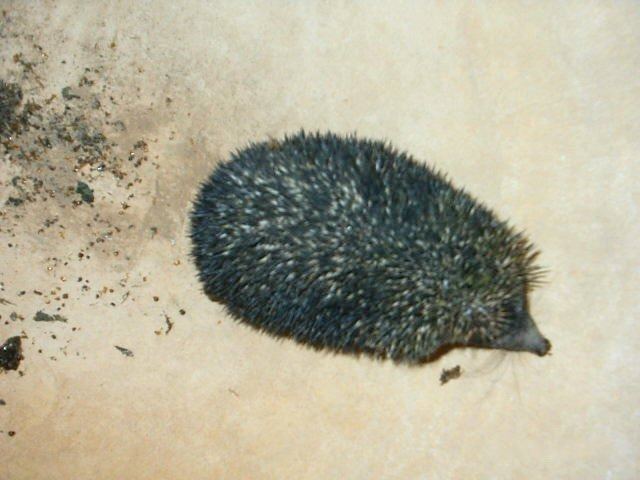This is a list of the mammal species recorded in Tajikistan. There are 51 mammal species in Tajikistan, of which 0 are critically endangered, 4 are endangered, 6 are vulnerable, and 3 are near-threatened.
The following tags are used to highlight each species' conservation status as assessed by the IUCN:
Some species were assessed using an earlier set of criteria. Species assessed using this system have the following instead of near threatened and least concern categories:
Rodents make up the largest order of mammals, with over 40 percent of mammalian species. They have two incisors in the upper and lower jaw which grow continually and must be keep short by gnawing. Most rodents are small though the capybara can weigh up to 45 kg (100 lb).
Suborder: Sciurognathi
Family: Sciuridae (squirrels)
Subfamily: Xerinae
Tribe: Xerini
Genus: Spermophilopsis
Long-clawed ground squirrel Spermophilopsis leptodactylus LR/lc
Tribe: Marmotini
Genus: Marmota
Long-tailed marmot Marmota caudata LR/nt
Menzbier's marmot Marmota menzbieri VU
Family: Gliridae (dormice)
Subfamily: Leithiinae
Genus: Dryomys
Forest dormouse Dryomys nitedula LR/nt
Family: Dipodidae (jerboas)
Subfamily: Allactaginae
Genus: Allactaga
Severtzov's jerboa Allactaga severtzovi LR/lc
Vinogradov's jerboa Allactaga vinogradovi LR/lc
Family: Cricetidae
Subfamily: Arvicolinae
Genus: Blanfordimys
Afghan vole Blanfordimys afghanus LR/lc
Bucharian vole Blanfordimys bucharicus LR/nt
Genus: Microtus
Juniper vole Microtus juldaschi LR/lc
Tien Shan vole Microtus kirgisorum LR/lc
Family: Muridae (mice, rats, voles, gerbils, hamsters, etc.)
Subfamily: Gerbillinae
Genus: Meriones
Midday jird Meriones meridianus LR/lc
Subfamily: Murinae
Genus: Nesokia
Short-tailed bandicoot rat Nesokia indica LC
The lagomorphs comprise two families, Leporidae (hares and rabbits), and Ochotonidae (pikas). Though they can resemble rodents, and were classified as a superfamily in that order until the early 20th century, they have since been considered a separate order. They differ from rodents in a number of physical characteristics, such as having four incisors in the upper jaw rather than two.
Family: Ochotonidae (pikas)
Genus: Ochotona
Large-eared pika Ochotona macrotis LR/lc
Turkestan red pika Ochotona rutila LR/lc
The order Erinaceomorpha contains a single family, Erinaceidae, which comprise the hedgehogs and gymnures. The hedgehogs are easily recognised by their spines while gymnures look more like large rats.
Family: Erinaceidae (hedgehogs)
Subfamily: Erinaceinae
Genus: Hemiechinus
Long-eared hedgehog Hemiechinus auritus LR/lc
Brandt's hedgehog Hemiechinus hypomelas LR/lc
The "shrew-forms" are insectivorous mammals. The shrews and solenodons closely resemble mice while the moles are stout-bodied burrowers.
Family: Soricidae (shrews)
Subfamily: Crocidurinae
Genus: Crocidura
Lesser rock shrew Crocidura serezkyensis LR/lc
Subfamily: Soricinae
Tribe: Soricini
Genus: Sorex
Buchara shrew Sorex buchariensis LR/lc
Eurasian pygmy shrew Sorex minutus LR/lc
The bats' most distinguishing feature is that their forelimbs are developed as wings, making them the only mammals in the world naturally capable of flight. Bat species account for about 20% of all mammals.
Family: Vespertilionidae
Subfamily: Myotinae
Genus: Myotis
Geoffroy's bat Myotis emarginatus VU
Fraternal myotis Myotis frater LR/nt
Subfamily: Vespertilioninae
Genus: Eptesicus
Botta's serotine Eptesicus bottae LC
Genus: Otonycteris
Desert long-eared bat Otonycteris hemprichii LR/lc
Subfamily: Miniopterinae
Genus: Miniopterus
Schreibers' long-fingered bat Miniopterus schreibersii LC
Family: Molossidae
Genus: Tadarida
European free-tailed bat Tadarida teniotis LR/lc
Family: Rhinolophidae
Subfamily: Rhinolophinae
Genus: Rhinolophus
Greater horseshoe bat Rhinolophus ferrumequinum LR/nt
Lesser horseshoe bat Rhinolophus hipposideros LC
There are over 260 species of carnivorans, the majority of which feed primarily on meat. They have a characteristic skull shape and dentition.
Suborder: Feliformia
Family: Felidae (cats)
Subfamily: Felinae
Genus: Acinonyx
Asiatic cheetah Acinonyx jubatus venaticus CR
Genus: Caracal
Caracal Caracal caracal LC
Genus: Felis
Jungle cat Felis chaus LC
Wildcat Felis silvestris LC
Pallas's cat Felis manul NT
Genus: Lynx
Eurasian lynx Lynx lynx NT
Subfamily: Pantherinae
Genus: Panthera
Persian leopard Panthera pardus ciscaucasica EN
Caspian tiger Panthera tigris virgata EX
Genus: Uncia
Snow leopard Uncia uncia EN
Family: Hyaenidae (hyaenas)
Genus: Hyaena
Striped hyena Hyaena hyaena LR/nt
Suborder: Caniformia
Family: Canidae (dogs, foxes)
Genus: Vulpes
Red fox Vulpes vulpes LC
Genus: Canis
Common jackal Canis aureus aureus LC
Tibetan wolf Canis lupus chanco LC
Eurasian wolf Canis lupus lupus LC
Genus: Cuon
Tien Shan dhole Cuon alpinus hesperius EN
Family: Ursidae (bears)
Genus: Ursus
Eurasian brown bear Ursus arctos arctos LC
Family: Mustelidae (mustelids)
Genus: Mustela
Stoat Mustela erminea LR/lc
Steppe polecat Mustela eversmannii LR/lc
Least weasel Mustela nivalis LR/lc
Genus: Lutra
European otter Lutra lutra NT
The odd-toed ungulates are browsing and grazing mammals. They are usually large to very large, and have relatively simple stomachs and a large middle toe.
Family: Equidae (horses etc.)
Genus: Equus
Turkmenian kulan Equus hemionus kulan EN
The even-toed ungulates are ungulates whose weight is borne about equally by the third and fourth toes, rather than mostly or entirely by the third as in perissodactyls. There are about 220 artiodactyl species, including many that are of great economic importance to humans.
Family: Cervidae (deer)
Subfamily: Cervinae
Genus: Cervus
Central Asian red deer Cervus affinis LR/lc
Family: Bovidae (cattle, antelope, sheep, goats)
Subfamily: Antilopinae
Genus: Gazella
Goitered gazelle Gazella subgutturosa VU
Subfamily: Caprinae
Genus: Capra
Markhor Capra falconeri EN
Genus: Ovis
Argali Ovis ammon VU
Mouflon Ovis orientalis VU
Genus: Pseudois
Bharal Pseudois nayaur LC

